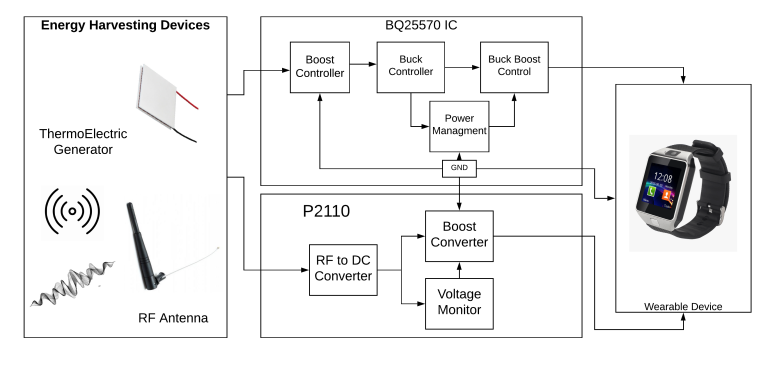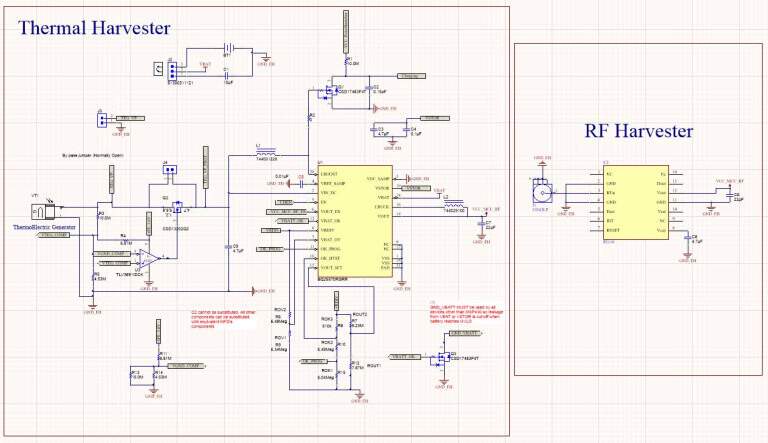

便携式设备的电源管理电路
电源/新能源
描述
技术进步的速度是难以想象的。从电子产品到计算机芯片,技术进步惊人。因此,我们发现自己被小工具包围,无论是智能手机、平板电脑、笔记本电脑、可穿戴设备还是其他物联网 (IoT) 设备。但是有一个领域仍然缺乏进展并延迟技术突破:电池的快速放电和低电荷存储。这将本文的重点放在可再生能源上,并利用这些能源为小工具自供电。
本文介绍的项目旨在开发两种类型的可再生能源,例如热能和射频 (RF)。通过这两种能源的集合,可以为超低功耗设备供电并影响物联网市场。
引言
根据物理定律,系统的总能量是守恒的,具有从一种形式转变为另一种形式的可能性。一个典型的例子是两个台球碰撞产生的“能量声音”和接触点产生的热量。在这种情况下,声音是一个源自周围空气分子振动的过程。这种振动在数学上可以表示为一种波,但对于人耳来说,它表现为一种声音,其强度与冲击力有关。因此,能量可以从一种形式转换为另一种形式。
有不同的环境能源可以从中获取电力。
- 热能。在我们周围的环境中,温度和热流的差异无处不在。典型的例子是来自汽车发动机的废热、来自地下的地热、来自钢铁厂冷却水或其他工业过程的热量。通过使用热电发电机和一些电路将热能转换为电能并将其保存到存储设备中,可以将热能转换为电能。基本原理是热电发电机(TEG)将热通量(温差)转化为电能。它们没有移动部件,通常尺寸非常小,非常适合低功耗嵌入式设备。
- 射频 (RF) 能量。今天,它代表了对无线传感器网络中电源的极大兴趣。通过无线配电系统,有可能拥有一个自组织基础设施,能够为由数百或数千个节点组成的整个网络供电,并使用单个传输源。
射频能量可以通过使用射频能量收集器转换为电能。这些采集器将射频能量转换为电能。今天,我们周围都有由 GSM、LTE、Wi-Fi、无线电波等产生的射频能量。所有这些信号都存在于任何商业、住宅和工业区域。
这些技术研发的真正挑战是恢复公共电信服务传输的电力,例如电视和无线电广播或移动通信。
项目
对于热能收集,我们将使用 BQ25570 IC,它可以从热电发电机中提取微瓦到毫瓦。它还有一个电源管理系统,通过使用双电路来提高电压,同时防止电池过度充电或爆炸。
For RF harvesting, we will be using the P2110 IC, and its RF antenna and front end. It is fine-tuned with the frequency band of 902–928 Mhz. It will operate on other bands as well but at lower efficiency. This band has a center frequency of 2G, which is all around us in any part of the living world, and it allows us to harvest energy in every part of the earth.
By combining these sensors, we can use these energies to self-power a gadget or a low-power wearable device. In this way, we do not need to recharge it after some time. The project can be combined with a supercapacitor for full ultra-low power management.
The block diagram for the integration of both RF and thermal harvesting circuits is shown in Figure 1.

Figure 1: Block diagram of the project
The components used in this project are as follows.
- 1 × TG.22.0222 (RF ANT 850-MHz/900-MHz WHIP RA)
- 1 × TG12-2.5-01LS (TEM GENERATOR 30 × 30 × 3.94 mm)
- 1 × BQ25570 IC
- 1 × P2110 IC
The electrical circuit for this project is shown in Figure 2.

Figure 2: Electrical circuit of the project
The process starts when the thermoelectric generator has enough difference of temperature across its plates to generate a voltage on its terminals. The power will be extracted by BQ25570, ranging from microwatts to milliwatts according to the temperature difference. Then the integrated boost converter will boost the voltage to 3.3 V at 93% efficiency.
Moreover, RF energy will be converted into electrical energy by the P2110 RF harvester. This RF power will enter at the antenna, and it will then convert to DC source through its integrated impedance matching circuit. A capacitor is added at the output to store power when the device is using less current than the harvester circuit is generating. Both powers will then be combined so that they can operate simultaneously. Even if one of the harvesting sources is weak, the other will continue providing power, and the system keeps running.
Important details for hardware design
For energy-harvesting purposes, there are two options: Either use capacitors to store the incoming power or use a battery to store that charge. We are using a capacitor in this project.
Here are some guidelines for selecting the capacitor:
- 选择具有低 ESR(小于 200 mΩ)的电容器。
- 泄漏电流在 1.2 V 时必须小于 1 μA。
- 大电容充电慢,但可以存储大量电流;小电容器充电非常快,并增加了启动时间。根据应用,可以使用以下公式更改电容器的值:C = 15 × Vout × Iout × Ton
在哪里:
- Vout = P2110 的输出电压
- Ton = IC 开启时间
- Iout = P2110 的平均输出电流
IC 的 RF 输入引脚可容纳任何标准天线。对于这个项目,使用了 50-Ω 天线,这对于大多数 RF 设备来说很常见,用于阻抗匹配。P2110 可以连接多种类型的天线。直流短路的天线必须有一个与天线串联的隔直电容器。
由于 RF 非常容易受到噪声和 EMI 干扰,因此在设计 PCB 时需要格外小心。最重要的是走线天线的阻抗匹配。由于这个天线是我们的电源,阻抗匹配得越多,这个采集器电路在射频侧的效率就越高。RF 走线必须严格为 50 Ω,并且长度必须尽可能短。
应使用过孔将 GND 引脚连接到电路板接地。所有电阻和电容必须尽可能靠近 IC。
RF 采集器和热采集器 IC 都使用具有高峰值电流和高开关频率的开关电源。PCB 布局需要特别小心,否则系统可能会出现 EMI 和稳定性问题。
大电流走线应具有短而宽的 PCB 走线。从地面返回的路径应尽可能短。旁路电容和存储电容应尽可能靠近 IC 的焊盘。尽量不要在电容器的路径中使用任何过孔。这些电容器在极端负载条件下为系统提供了很大的稳定性。
为了存储从热收集器收集的能量,我们将添加一个电容器。当采集器不再采集电力时,该电容器将足够大以向设备供电。
两台收割机的输出功率将合并。这样可以提高总功率输出,最大限度地利用两种环境能量。在任何情况下,如果热能不够,设备将从射频采集器获取电力;或者如果射频功率较弱,热能将持续提供能量。在其他情况下,如果两种电源均不可用,则两个采集器的存储电容器将保持系统开启,但时间有限。热收集器的好处是它可以用于那些产生热量并偶尔使用散热器散热的系统中。这种热量收集解决方案非常适合这些情况,因为您不需要使用散热器,并且热量将被转换回系统,
越来越高效的设备的出现可以为充分利用能量收集的新解决方案铺平道路。
审核编辑:刘清
-
电源管理策略推动便携式设计发展2023-11-16 404
-
针对便携式设备的电源管理方案2021-11-17 1381
-
求一套便携式设备的电源管理方案2021-07-26 887
-
新一代便携式设备的关键电源电路设计需要考虑哪些方面?2019-11-06 1789
-
便携式设备带给大家新的体验2019-06-26 2034
-
便携式设备中的电源效率2015-10-02 1838
-
电源IC在便携式移动设备领域的应用2015-09-29 3194
-
用于便携式及无线应用的便携式电源管理2012-08-16 2913
-
便携式医疗应用的电源管理技术2011-02-12 793
-
便携式产品的电源管理2009-12-21 483
-
新一代便携式设备的关键电源电路设计考虑2009-12-05 1016
-
便携式应用处理器的电源管理技巧2009-04-27 471
-
便携式设备电源设计攻略2008-12-01 808
全部0条评论

快来发表一下你的评论吧 !

